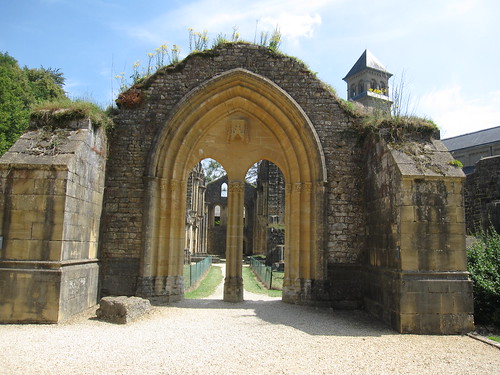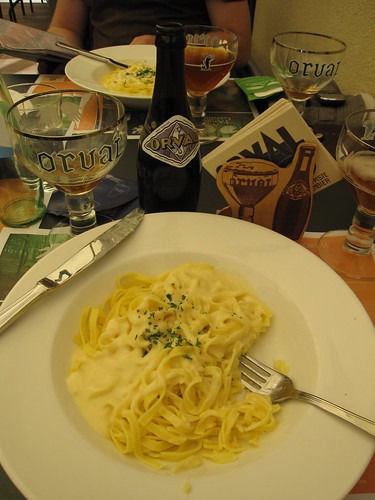 |
| The Authentic Trappist Product logo. |
Trappist beer
Trappist beer is not really a beer style, even though you will often find them listed under the same heading at beer pubs around the world. A Trappist beer can be blond or dark, it can be sweet or dry, it can be strong or it can be low in alcohol. The only thing that unites the Trappist beers is how they are made: They have to be brewed at a Trappist monastery and by the monks (though there is some leeway, the monks can hire secular workers to handle some of the brewing operations).In 1997, eight Trappist monasteries founded the International Trappist Association to prevent non-Trappist companies from abusing the Trappist name. Their Authentic Trappist Product logo can only be carried by products that have been made at genuine Trappist monasteries - be it cheese, jam or beer.
Today there are seven Trappist monasteries brewing beer, one located in the Netherlands - the Onze Lieve Vrouw van Koningshoeven known for their La Trappe series - and six in Belgium: Abbaye Notre-Dame de Scourmont (Chimay), Sint-Benedictusabdij de Achelse Kluis (Achel), Abdij Sint-Sixtus (Westvleteren), Abdij van Onze-Lieve-Vrouw van het Heilig Hart (Westmalle), Abbey of Notre-Dame de Saint-Rémy (Rochefort) and Abbaye Notre-Dame d'Orval (Orval). I've noted the name of their beers in parentheses. There is also a Trappist monastery in France, L'abbaye du Mont des Cats, but their Biere Trappiste is brewed by the Trappist monks in Scourmont and so does not qualiify as an authentic Trappist beer.
This post is about one of the six Belgian Trappist breweries: Abbaye Notre-Dame d'Orval.
 |
| Ruins of the old Orval Abbey, destroyed in 1793. |
Abbaye Notre-Dame d'Orval
Abbaye Notre-Dame d'Orval or Orval Abbey was founded in 1132 by a group of Cistercian monks from the Trois-Fontaines Abbey in Champagne, who settled in the remote Gaume region in the far south east of Belgium, just a kilometer north of France, in what is now known as the Belgian province of Luxembourg. |
| Trout with a golden ring. |
Despite wars and fires the abbey functioned for more then six hundred years, until 1793 when the French Revolution arrived at their gate. In revenge for having sheltered Austrian troops, the French revolutionary troops burned down the abbey and dispersed the monks. Just like they soon would do with the monasteries in Bavaria.
For a hundred years all that remained were the ruins, but in 1887 the land and ruins were acquired by the Harenne family. In 1926, they made a donation of it to the Cistercian order, allowing them to return and rebuild the Orval Abbey. Between 1926 and 1948, the new monastery was constructed, and in 1935 Orval regained the rank of abbey.
Orval Trappist Beer
In 1931, the monastery hired the German brewmaster Martin Pappenheimer (1883-1942) to create a recipe for a beer they could brew. Together with the two Belgian brewers, Honoré Van Zande and John Vanhuele, who were employed to brew at the monastery, he came up with a unique recipe. |
| Orval Trappist Beer. |
To this day, Orval only brews this one beer of 6.2% ABV, though they also make a weaker 3.5% ABV version, called Petite Orval, for use by the monks at the monastery.
Orval beer is sold in a specially designed bottle and served in a specially designed Orval glass. And if you look closely at the logo on a bottle you will notice the jumping trout with the golden ring in its mouth, mentioned above in the Countess Mathilde myth. Supposedly, the well that fed the fountain where Mathilde lost her ring is the same well that is used as water supply when brewing the Orval.
A l'Ange Gardien
In July 2011, the monastery opened up a restaurant and tasting room, called A l'Ange Gardien, just outside the walls of the abbey. A l'Ange Gardien, which is French for "guardian angel", serves beer and cheese made at Orval Abbey, allowing visitors to enjoy the Trappist treats almost onsite. |
| Tagliatelles à la crème d'Orval |
The restaurant has a good food menu too, usually with ingredients from the abbey - such as the delicious tagliatelle dish I had which came with melted Orval cheese on top. It went really well with the beer.
I highly recommend a visit to the beautiful and tranquil Orval, the only downside is that you really need a car to get there - it is too remote for public transport to have discovered the place. Which is part of the charm anyway :)
Photos from the visit to Orval can by found at Flickr.
No comments:
Post a Comment